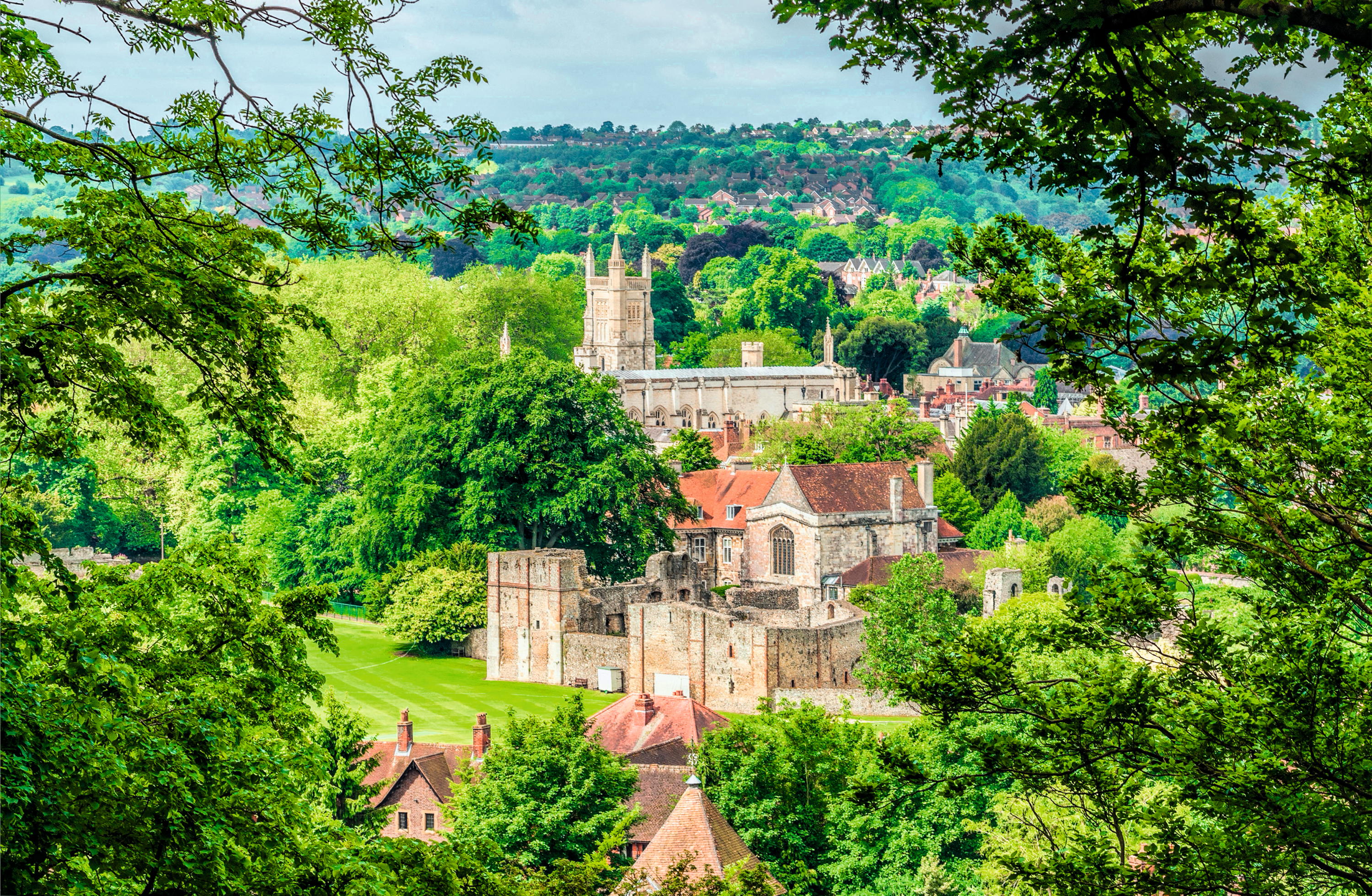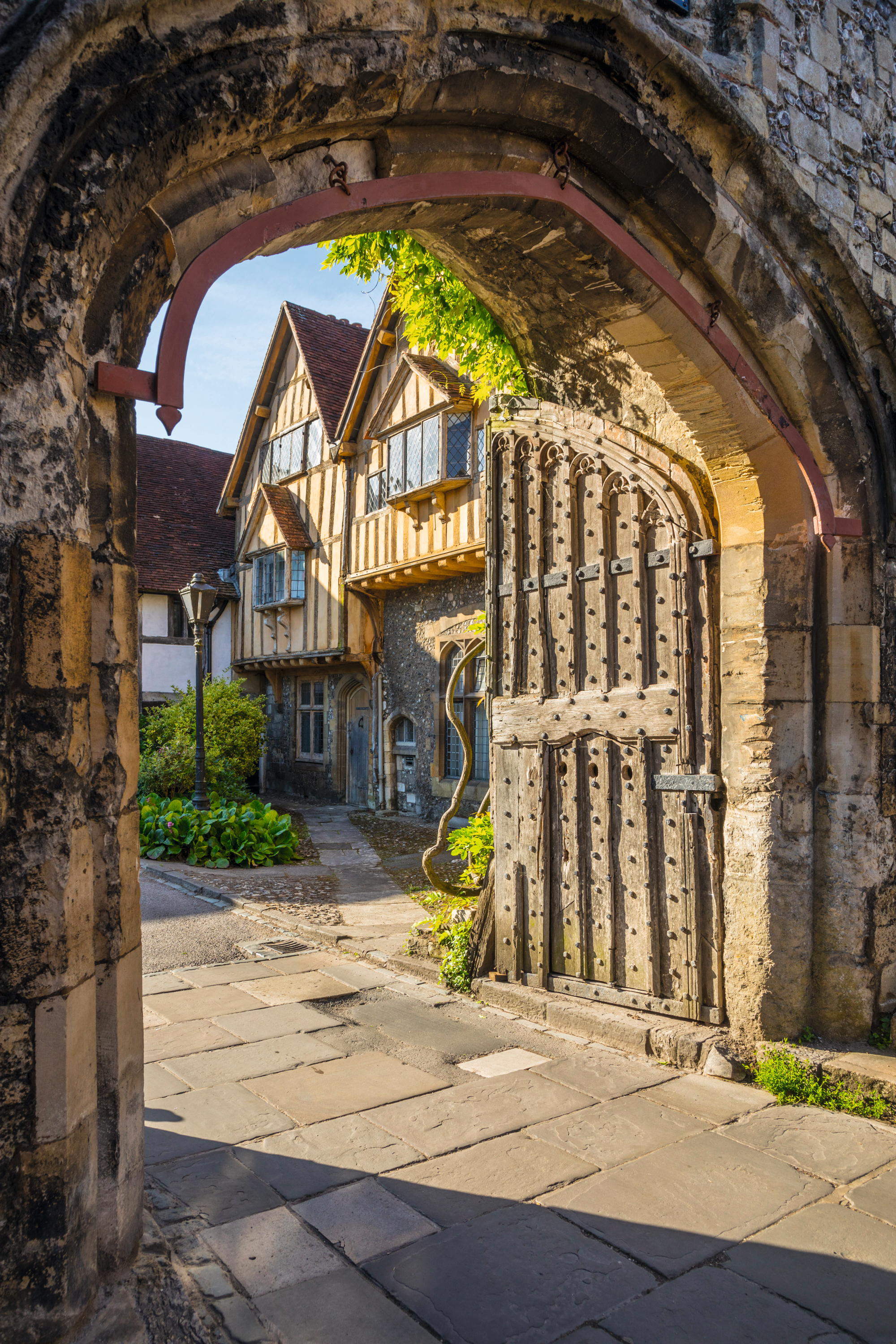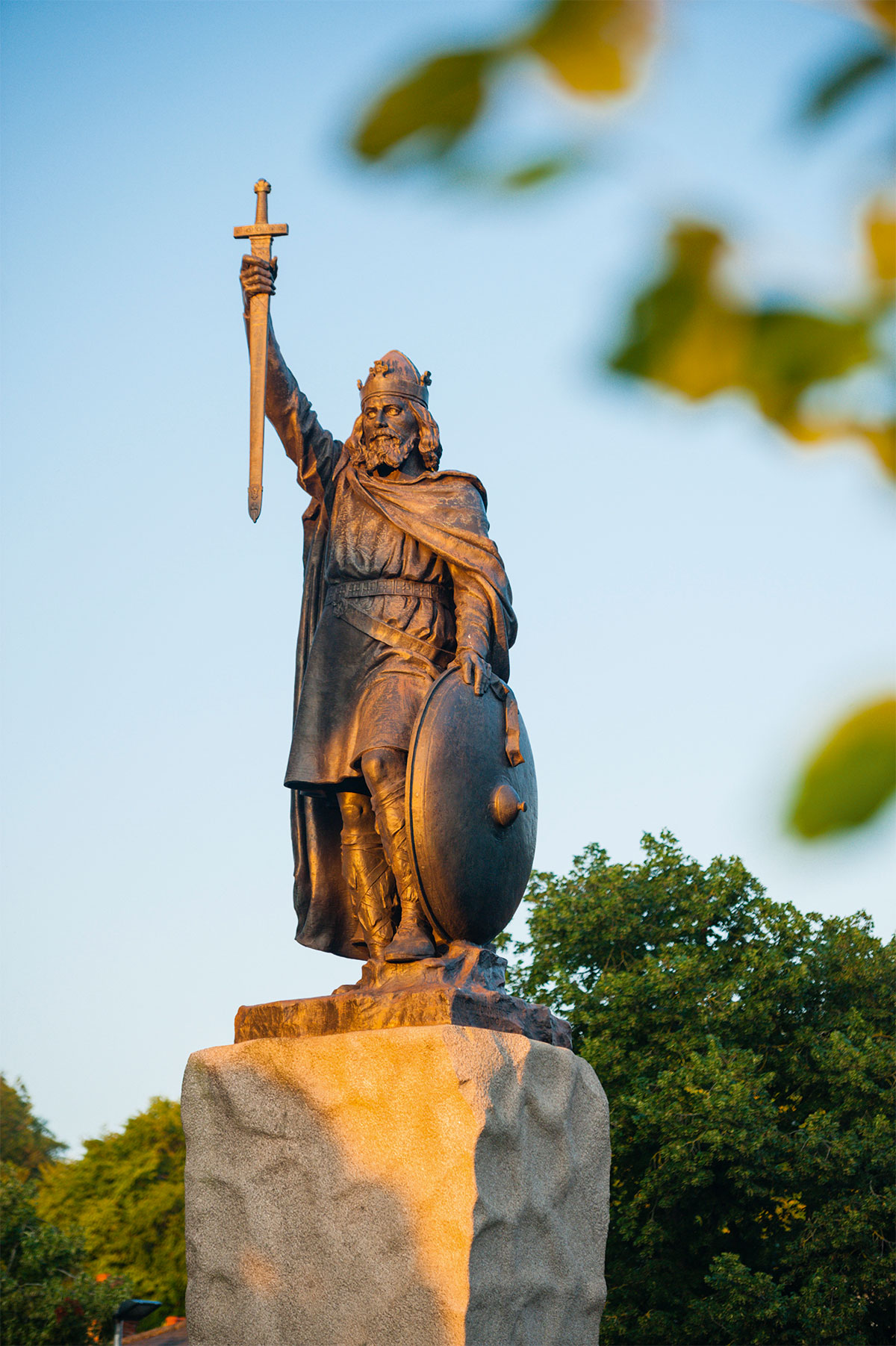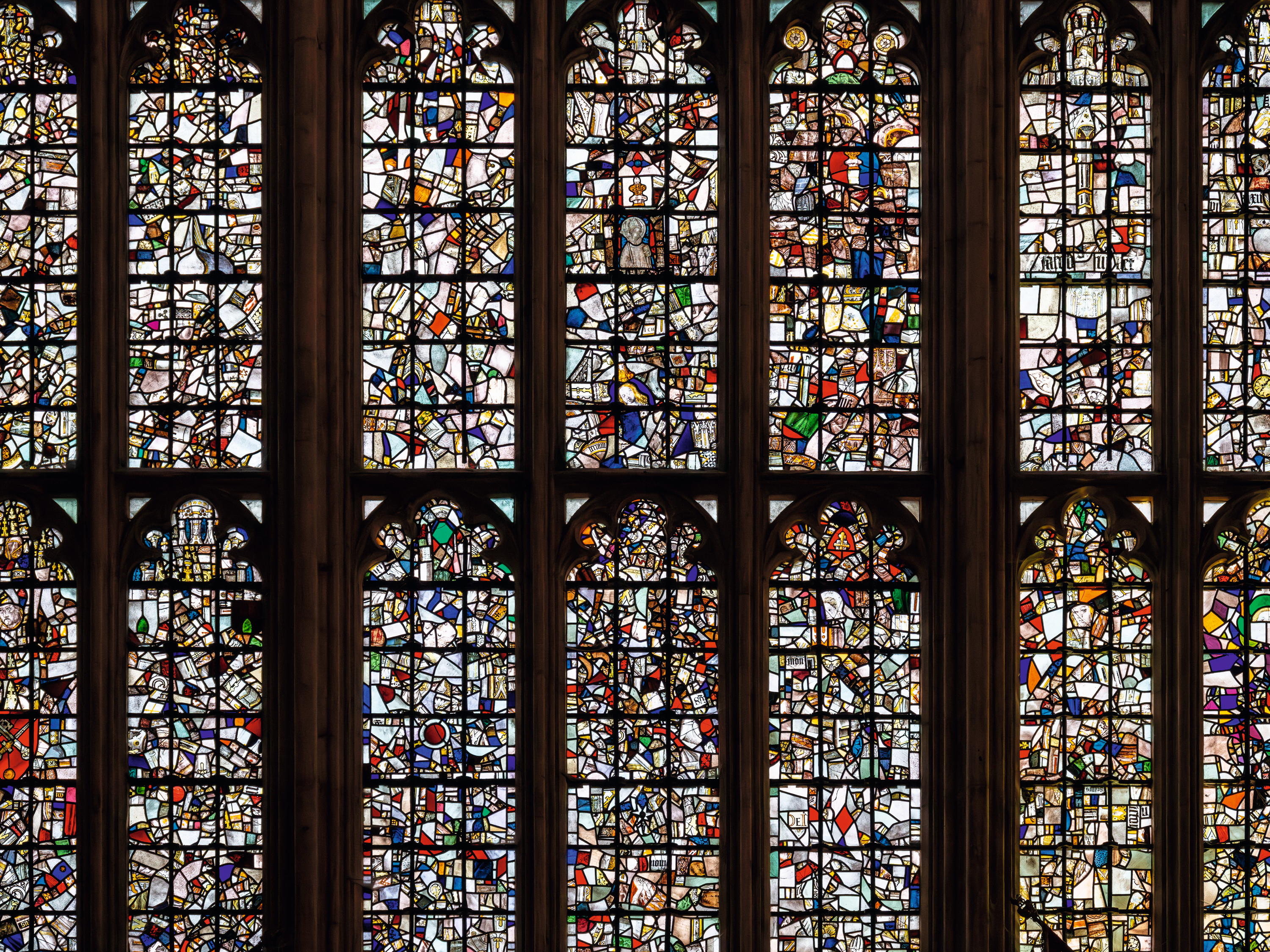Winchester: The ancient city of kings and saints that's one of 21st century Britain's happiest places to live
Kings, cobbles, secrets, superstition and literary fire power–Winchester has had it all in spades for centuries and is as desirable now as it ever was, says Jason Goodwin.

Set into the flint wall that runs between the Abbey Gardens and the Paradise, at the eastern end of Winchester Cathedral, is a low archway picked out in brick, shuttered up with stone. Into it is distilled the history of Winchester and, perhaps, the secret of its agreeable charm: humble and royal, churchy, but not stuffy, practical and unobtrusive and layered, like the city around it, in wreaths of legend and fantasy. Throw in excellent schools, a buzzing, cobbled centre, trains to London in less than an hour and glorious, rolling river valleys on the doorstep and it’s easy to see why the ancient capital of Wessex is consistently ranked among the happiest places to live in the UK.
Winchester has always loved its kings — and the kings loved Winchester. ‘The king in Winchester, the primate in Canterbury, “like two strong oxen pulled the plough of England”,’ wrote Hilaire Belloc in The Old Road (1904), which charted the pilgrim way between the two cities. The bones of Saxon and early Norman kings and queens are to be found above the choir in the cathedral, in reliquary chests called Foxe’s Boxes (after a wily 16th-century bishop); they have been hopelessly jumbled up ever since Cromwell’s invading Puritans used them to smash the stained-glass windows.
The violence unleashed on Winchester and its cathedral and castle after its capture by Parliamentary troops in 1642 reflects the depth of the city’s Royalist and Anglican loyalties. Perhaps the most magnificent symbol of Winchester’s sympathies is the extraordinary sweep of the Great West Window in the cathedral. Originally arrayed with the usual panoply of saints and saviours, the medieval glass, shattered by the Puritans, was swept up and hidden by the townspeople in bags and boxes until, almost 20 years later, with the Restoration, its fragments were reset in a glittering mosaic, creating an astoundingly abstract testament to memory and faith.

Charming Cheyney Court, once the Bishop of Winchester’s courthouse.
More stolidly representational is Thorneycroft’s heroic statue of Alfred the Great outside, sword raised, helmeted and warlike, which sets the royal tone as the visitor arrives across the Itchen. Winchester was already a cathedral city with the building of the first Old Minster in 676 and, under Alfred (849–899), it became the chief city of Wessex, as the King set out to revive law and learning and rebuild the country’s defences against the Danes. The statue, raised to commemorate the 1,000th anniversary of Alfred’s death, speaks to the Victorians’ enthusiasm for Saxon England, the kernel of empire.

Royal greeting: city visitors are met by Thorneycroft’s statue of a warlike Alfred the Great.
However, Winchester’s favourite king must be Charles II, whose restoration liberated this Anglican stronghold from Puritanical gloom. He started to build a second Versailles overlooking the city, with plans for a grand sweeping staircase down to the cathedral. Neither, perhaps mercifully, materialised; autocratic, continental grand slams are not really Winchester’s thing (Sir Christopher Wren’s unfinished palace became a barracks, The Peninsula; rebuilt after a fire, it now houses flats for well-heeled Wintonians).
More lastingly influential was Charles II’s ordinance that stipulated brick in place of timber, following the Great Fire of London in 1666. Although a number of handsome, half-timbered buildings survive, many were sheathed in elegant brickwork in the Georgian era and significant buildings, especially around the cathedral close, were built in brick that mellows engagingly with time. Mellow, incidentally, is a very Winchester epithet, which sprang to Keats’s mind when he wandered the Itchen meadows two centuries ago and wrote his ode To Autumn.

Mellow meadows: John Keats found inspiration for his celebrated ode To Autumn when taking a wander through the water meadows to the south of the city in September 1819.
Charles II is the one who had the brick arch built into the flint wall. He typically stayed in the delightful house designed by Wren for the Dean of Winchester, who had stoutly refused the King’s request to allow his mistress into the house; the King, after all, was the head of the Anglican church. The doorway was a classic Wintonian compromise, by which Charles was able to stay with the Dean and yet slip out of the cathedral precinct to visit his girlfriend, Nell Gwynne, installed in one of the little houses beyond the wall.
Exquisite houses, the beauty of Nature, and how to get the most from your life, straight to your inbox.
After Charles’s death, the door was blocked up, to drift on down the centuries as a memento of another age. Erasure hasn’t been Winchester’s style — not until the 1950s, when architectural planners from the county council, in the space of a few years, did more violence to the medieval town than Cromwell’s troops had ever done. The row of houses beyond the wall was demolished, together with hundreds of others, leading to the timely creation of the City of Winchester Trust in 1957, which has kept its eagle eye on new developments ever since.
It’s worth following the line of the part-cobbled High Street — now a vibrant jumble of market stalls most Thursdays to Sundays — as it makes its way up from the bridge and Broadway to the Westgate. Winchester claims many (suitably modest) records: a grandson of William the Conqueror founded the Hospital of St Cross, believed to be England’s oldest charitable institution, where pilgrims can still claim bread and beer; Winchester College is England’s oldest public school; the cathedral not only boasts Europe’s longest nave, but is also the only one in the world to be immortalised in a No 1 chart hit (Winchester Cathedral was released in 1966 by The New Vaudeville Band); and the Royal Oak claims to be the oldest pub in England, serving pints since 1002.

Top table: this 13th-century replica of King Arthur’s Round Table adorns the city’s Great Hall.
The High Street is apparently England’s oldest, developed from an animal track that crossed the Itchen where the river splits around an island of gravel, a track taken by the earliest hunters and, later, by traders and travellers who gave the settlement a habitation and a name. The side streets follow ledges carved from the chalk by the river, in times of melting glaciers: on arrival, the Romans had only to mark them out. They called the city Venta Belgarum (‘market town of the Belgae’) and gave it defensive walls as it grew in importance. The Saxons later knew it as the Venta fortress, Wintancaester.
The High Street climbs from the river bed towards the city walls, passing by the slender Buttercross, an early 15th-century monument where butter was stacked out of the sun on market days, under the famous 18th-century clock on the old Guildhall and past an Elisabeth Frink sculpture of a man on horseback, who signals the entrance to the law courts; in former times, Sir Walter Raleigh was tried for treason in the Great Hall and the trial of IRA bombers was held here in 1973 after they damaged the Old Bailey. The Great Hall, with its magnificent hammerbeam roof, is a remnant of the castle that stood until the Civil War. It famously contains the Round Table of King Arthur and his knights, probably fashioned for a tournament held by Edward I — by the 13th century, Winchester must already have felt so ancient, it was easily taken for Camelot. The Tudors, too, stressed their Arthurian inheritance, with Henry VIII having himself painted onto the table to entertain Emperor Charles V in 1522.
The castle was one of the first Norman buildings in England, constructed by William the Conqueror when he chose Winchester as a power base. Shortly afterwards, he ordered the creation of an awe-inspiring cathedral. So briskly after the Conquest did construction begin — in 1079 — that the Saxon masons had to learn their trade on the job; the early work on the north transept is endearingly full of yawning gaps and wonky pillars. The nave itself was rebuilt in the 14th century in the latest soaring Perpendicular style. For all that, the cathedral maintains an air of modest sufficiency, like Goldilocks’s porridge, especially from the outside. Salisbury’s spire rises to 404ft; Winchester’s tower is only 150ft, but, as the city looks down on the cathedral, it is enough.
Across the close, beyond the medieval Kingsgate with its tiny church of St-Swithun-upon-Kingsgate, the Wykeham Arms invites literary pilgrims to stop and admire the Victorian postbox designed by Anthony Trollope, its inventor, whose ‘Barchester’ novels helped to define the character of our cathedral cities. Barchester is not Winchester; it is Salisbury, but Trollope gave his cathedral Winchester’s squat tower, perhaps as a disguise. Certainly, he knew Winchester well, having spent three (miserable) years at the famous College founded by the great Bishop William Wykeham in 1382. The college motto is ‘Manners Makyth Man’ and it has a reputation for producing brilliant, perhaps slightly devious, insiders: T. H. White sent his Merlin there and Yes Minister’s Sir Humphrey is an Old Wykehamist.
More likely, however, literary pilgrims come to see the Itchen meadows, full of Keats’s mellow fruitfulness, or to genuflect at the shrine of Hampshire’s most famous daughter, Jane Austen, whose ironic wit chimes perfectly with Winchester’s air of professional gravity — this is a city of lawyers, architects, doctors and military officers. Austen lived at Chawton about 15 miles east and came to Winchester in her final weeks. She is buried in the north aisle of the cathedral, beneath a slab of black stone that praises her goodness; her novels are mentioned only in a brass plaque erected later and referred to in a stained-glass window. This anniversary year, a life-size sculpture of the author will be installed outside the cathedral; No 8, College Street, where she spent her final weeks, opens to the public for the first time today (until August 30) and ‘Beyond the Bonnets’ at The Arc examines working women in Austen’s novels (July 26–November 2).
In the south transept, in a small side chapel, lies Izaak Walton, the author of The Compleat Angler (1653), complete with a memorial window raised by the fishermen of England and America in 1914. It features him reading by the River Itchen, with St Catherine’s Hill in the background, and the motto ‘Study to be Quiet’. Walton’s gentle angler shied away from the buffeting of affairs during the upheavals of the Civil War and retired into the beauties of Nature and the Creation, which he found in the gentle hills and chalkstreams of Hampshire. With his book still in print, he, perhaps, is Winchester’s ambassador to the world.

Magnificent mosaic: the vast sweep of the cathedral’s Great West Window is fashioned from fragments of the medieval glass that were hidden after being smashed by Puritans.
Life in Winchester
With a population of about 45,000 and only an hour by train from London, Winchester consistently pops up top of the list of desirable places to live in Britain and it has a very high happiness quotient.
There are plenty of handsome period houses and elegant residential streets in St Cross, within walking distance of the lively city centre, and the leafy streets of Weeke are full of big houses, with the city’s average house price at £520,000. Young scholars are spoiled for choice — there’s The Pilgrims’ School for boys in the town, with Twyford and Prince’s Mead on the outskirts, the famous college for (mostly) boys, St Swithun’s for girls, and the excellent Kings’ School and Peter Symonds sixth-form college.
The Christmas market, by the cathedral cloisters, is one of the best in Europe and, every July, musicians, magicians and acrobats descend for the Hat Fair, the UK’s longest-running festival of outdoor arts. Further culture can be found at The Arc gallery and library, in the former Corn Exchange. Restaurants include The Chesil Rectory — modern British food in a 600-year-old house — or the walled garden at the original Hotel du Vin. The Wykeham Arms is a delightful place to eat, stay or pop in for ‘a quickie at the Wykie’, in the oldest part of town outside the walls, and the farmers’ market is a draw on the High Street. The biggest in the UK, it is held every second and last Sunday of the month, with stalls selling local goodies from watercress to Hampshire pork.